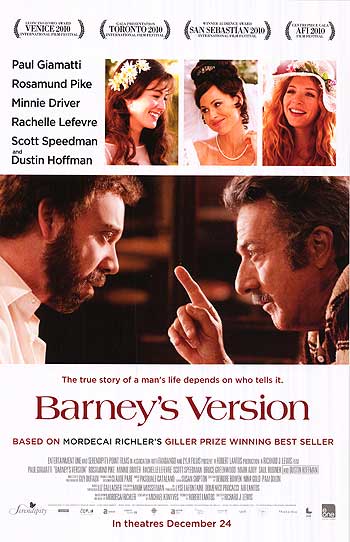
In naming a film Barney’s Version, a viewer, or at least this viewer, might expect that the film is a telling of a series of events as seen through the eyes of the titular Barney. And that the main character’s "take" on the events of his own life might be rife with the sort of delusions and imagined outcomes we as human beings are prone to. The interest of the film would lie in sifting through the truths and the imagined truths of the story and learning about the title character’s personality through this deciphering. Richard J. Lewis’ film Barney’s Version manages, with the great help of Paul Giamatti’s shambling performance as Barney, achieve half of the equation: the film adequately tells a version of Barney’s life, but one surprisingly mundane in its delivery, rife with cliché and straightforwardness.
Based on the
novel by Canadian novelist Mordecai Richler (referred to as
a Canadian Saul Bellows), Barney’s Version follows
the remembrances of a surly, oft times drunken television
producer Barney Panofsky as he looks back on the trials and
tribulations, loves and losses of his life. The film follows
Barney as his boozes his way through three marriages (to
three very attractive women - Rachel Lefevre, Minnie Driver,
and Rosamund Pike), supporting his friends and family along
the way. At some point there’s a murder of Barney’s best
friend Boogie (played with able drug-addled jitter by Scott
Speedman) and a few wildly romantic flourishes by the
drunken protagonist, but Barney is man-child, a bundle of
love and emotion and caring that can’t seem to propel itself
in to maturation. Barney Panofsky has the potential of being
a truly great character and Giamatti does an amazing job of
making Barney a prickly teddy bear, bouncing between bawling
and explosive anger and rough-edged sentiment at the drop of
a pin, and the film struggles to keep up. Instead of a
sharp, biting look at the life of a thickly-layered man,
Lewis creates a cloying look a thickly-layered man’s life.
|
